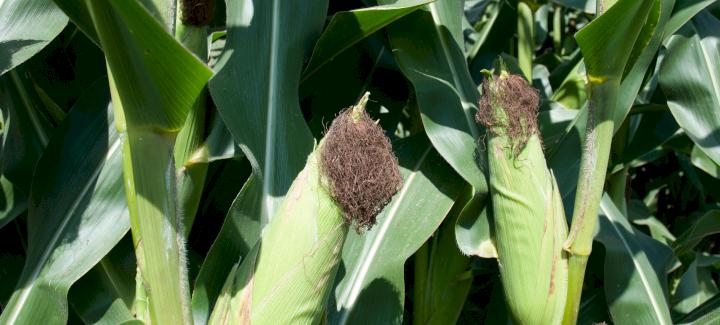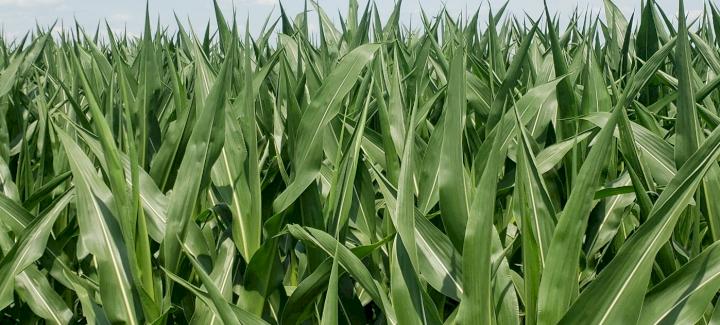Stine’s 2022 corn lineup has yield plus options that fit different growing environments. From our full line of Agrisure® corn traits to our own Stine GT™ and conventional options, Stine has you covered. Learn more about some of our top yielders in the field year after year and what our experts have to say about their performance.
Stine 9202-G Brand Corn
Part of the Stine 9202 genetic family, Stine 9202-G is an 85–87-day relative maturity hybrid that features glyphosate tolerance. This product broadly adapts west to east and has good stress tolerance, including tolerance to northern corn leaf blight. With excellent roots and stalks, this product produces plants that stand up to varying weather elements and other stressors. As an HP Corn® designated product, Stine 9202-G has a positive response to higher populations. It also boasts the Agrisure Artesian® trait for optimum performance in drought-like conditions. Stine Corn Technical Agronomist Tony Lenz notes that this is a great traditional-looking taller hybrid. “It’s a good silage option but still works very well for grain yields. It’s been a stable hybrid in our lineup for many years,” he adds. Stine RSA Jason Ashley notes, “9202-G has been a very good and popular hybrid in my northern region (south central Minnesota). It has emerged extremely well and can handle stress and some of the sandier rougher soils to the north. It stands well and continuously yields well, which has made several of our customers really like this corn.”
Stine 9728E-20 Brand Corn
A 109–111-day relative maturity product, Stine 9728E-20 works well in variable soil types. It features the Agrisure Viptera® 3110 trait for season-long insect control and herbicide flexibility with both glyphosate and glufosinate (Liberty®) tolerance. This is a great choice for lower planting populations and produces excellent roots and stalks for outstanding standability and performance. Stine 9728E-20 also features very good disease resistance and structured refuge in the bag. Stine RSA Kurt Johnson notes this is a go-to product in his region (central Kansas and central south-central Nebraska). “The two modes of action above ground provide the necessary season-long protection we need in our region. I consider this a workhorse type hybrid that adapts to variable soil types, providing top yields on our soils. We plant this hybrid in dryland and irrigated situations and have had excellent results in both,” he adds.
Note: 20% structured refuge required in corn-growing areas; 20% structured refuge required in cotton-growing areas. Consult the Syngenta Stewardship Guide for additional refuge requirements.
Stine 9808E-20 Brand Corn
This 114–116-day relative maturity product is a leader in our southern region. It works especially well in loam to clay-loam soils and has very good disease protection coupled with excellent roots and stalks. It works well in all row widths and features the Agrisure Viptera 3110 and LibertyLink® traits for tolerance to glyphosate and glufosinate herbicides. Stine RSA Kevin Ryan (Delta South) notes, “9808E-20 has been a continuing performer in the south. It has excellent emergence in the cooler, wet soils and fast drydown for early harvest.” He adds, “I like to see a mid-season nitrogen application with sulfur to maximize the yield potential of this hybrid.” Stine Corn Technical Agronomist Mike Smith agrees that 9808E-20 is a leader in the south and is as an excellent workhorse type product for variable soil types. He says, “On the higher-yielding soils, I recommend increasing the population as this hybrid will respond to season-long fertility applications. We also see a nice response to early (V6) and late (VT) fungicide applications.”
Stine 9814-20 Brand Corn
Stine 9814-20 brand corn boasts the Agrisure Viptera 3110 and LibertyLink traits for herbicide flexibility with tolerance to both glyphosate and glufosinate herbicides. This is a 117–119-day relative maturity product that features best-in-class above-ground insect control. The product works well in variable soil types and produces taller plants with excellent late-season health and grain quality for great silage appeal. This is an excellent choice for lower planting populations. Stine RSA Kevin Krabel (central Illinois) notes, “9814-20 is a great silage hybrid for growers who want tonnage. This hybrid is a good workhorse type hybrid in the clay loam soils up north and it gives consistent yield results over diverse corn acres.”
To learn more about Stine’s corn lineup, contact your local Stine sales rep today.
![YIELD[+]](/images/site/global/logos/yield-plus.png)



